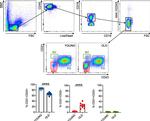Search Thermo Fisher Scientific
Invitrogen
CD93 (AA4.1) Monoclonal Antibody (AA4.1), Super Bright™ 600, eBioscience™
FIGURE: 1 / 3
CD93 (AA4.1) Antibody (63-5892-82) in Flow



Product Details
63-5892-82
Species Reactivity
Published species
Host/Isotype
Recommended Isotype Control
Class
Type
Clone
Conjugate
Excitation/Emission Max
Form
Concentration
Purification
Storage buffer
Contains
Storage conditions
Shipping conditions
RRID
Product Specific Information
Description: The AA4.1 monoclonal antibody reacts with mouse C1qRp, an approximately 130-140 kDa C-type lectin-like type I transmembrane protein. The AA4.1 antigen was originally identified as an antigen expressed on early stages of B cell development in bone marrow. Adult spleen and fetal liver also have detectable numbers of AA4.1 positive cells. In combination with other markers of hematopoietic progenitor cells such as Thy-1, Sca-1, c-Kit, CD43, and CD24, the bone marrow Lymphoid-Committed Progenitors (CLP) can be segregated into more primitive and more differentiated subsets based on expression of AA4.1. Correlated expression of surface IgM (sIgM), CD23, and AA4.1 antigen has also been used to define three nonproliferative subpopulations of immature/transitional peripheral B cells designated: T1 (AA4.1+/CD23-/sIgMhi), T2 (AA4.1+/CD23+/sIgMhi), and T3 (AA4.1+/CD23+/sIgMlo). AA4.1 is also reported to be expressed in cytoplasmic vesicles in endothelial cells, megakaryoblasts, and platelets. It is reported that monoclonal antibodies AA4.1 and 493 recognize different epitopes of the same molecule.
Applications Reported: This AA4.1 antibody has been reported for use in flow cytometric analysis.
Applications Tested: This AA4.1 antibody has been tested by flow cytometric analysis of mouse bone marrow cells. This may be used at less than or equal to 0.125 µg per test. A test is defined as the amount (µg) of antibody that will stain a cell sample in a final volume of 100 µL. Cell number should be determined empirically but can range from 10^5 to 10^8 cells/test. It is recommended that the antibody be carefully titrated for optimal performance in the assay of interest.
Super Bright 600 is a tandem dye that can be excited with the violet laser line (405 nm) and emits at 600 nm. We recommend using a 610/20 bandpass filter. Please make sure that your instrument is capable of detecting this fluorochrome.
When using two or more Super Bright dye-conjugated antibodies in a staining panel, it is recommended to use Super Bright Complete Staining Buffer (Product # SB-4401) to minimize any non-specific polymer interactions. Please refer to the datasheet for Super Bright Staining Buffer for more information.
Light sensitivity: This tandem dye is sensitive to photo-induced oxidation. Please protect this vial and stained samples from light.
Fixation: Samples can be stored in IC Fixation Buffer (Product # 00-8222) (100 µL of cell sample + 100 µL of IC Fixation Buffer) or 1-step Fix/Lyse Solution (Product # 00-5333) for up to 3 days in the dark at 4°C with minimal impact on brightness and FRET efficiency/compensation. Some generalizations regarding fluorophore performance after fixation can be made, but clone specific performance should be determined empirically.
Excitation: 405 nm; Emission: 600 nm; Laser: Violet Laser
Super Bright Polymer Dyes are sold under license from Becton, Dickinson and Company.
Target Information
The protein encoded by this gene is a cell-surface glycoprotein and type I membrane protein that was originally identified as a myeloid cell-specific marker. The encoded protein was once thought to be a receptor for C1q, but now is thought to instead be involved in intercellular adhesion and in the clearance of apoptotic cells. The intracellular cytoplasmic tail of this protein has been found to interact with moesin, a protein known to play a role in linking transmembrane proteins to the cytoskeleton and in the remodelling of the cytoskeleton.
For Research Use Only. Not for use in diagnostic procedures. Not for resale without express authorization.
How to use the Panel Builder
Watch the video to learn how to use the Invitrogen Flow Cytometry Panel Builder to build your next flow cytometry panel in 5 easy steps.
Bioinformatics
Protein Aliases: C1q receptor; C1q/MBL/SPA receptor; C1qR(p); CD93; Cell surface antigen AA4; Complement component 1 q subcomponent receptor 1; complement component 1, q subcomponent, receptor 1; Complement component C1q receptor; Ly-68; Lymphocyte antigen 68
Gene Aliases: 6030404G09Rik; AA145088; Aa4; AA4.1; AW555904; C1qr1; C1qrp; Cd93; Ly68
UniProt ID: (Mouse) O89103
Entrez Gene ID: (Mouse) 17064

Performance Guarantee
If an Invitrogen™ antibody doesn't perform as described on our website or datasheet,we'll replace the product at no cost to you, or provide you with a credit for a future purchase.*
Learn more
We're here to help
Get expert recommendations for common problems or connect directly with an on staff expert for technical assistance related to applications, equipment and general product use.
Contact tech support

